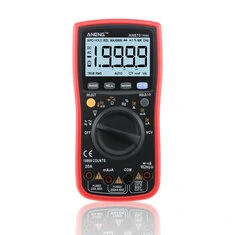
|
With its four and a half decade display, its specified accuracy of ±0.05 % when measuring DC voltage and its price of less than EUR 30, this sturdy multimeter is well worth an extensive test. |
Getting to know the Aneng AN870 multimeter
Alternative brands, names and prices
This multimeter is offered under various brand names and type numbers:
- Aneng AN870
- Zotek ZT219 (is Zotek the real manufacturer?)
- Richmeters RM219
The prices vary considerably, from € 17.54 to € 52.14 (January 2021). Nevertheless, a comment must be made here. The multimeter is identical for all suppliers. What is different is the number of measuring probes that are supplied by the various suppliers. Some cheap deals only include one set of measuring probes. We bought our Aneng AN870 at Banggood for € 30.54 with a very complete set of measuring leads.
What can you measure with the AN870?
This multimeter has a very extensive number of measuring functions, which you can select with a ten-position rotary switch and the 'SELECT' and 'Hz/%' push buttons:
- DC voltage: 19.999 mV ~ 199.99 mV
- DC voltage: 1.9999 V ~ 19.999 V ~ 199.99 V ~ 1000.0 V
- AC voltage: 19.999 mV ~ 199.99 mV
- AC voltage: 1.9999 V ~ 19.999 V ~ 199.99 V ~ 750.0 V
- DC current: 199.99 μA ~ 1999.9 μA
- DC current: 19.999 mA ~ 199.99 mA
- DC current: 1.9999 A ~ 19.999 A
- AC current: 199.99 μA ~ 1999.9 μA
- AC current: 19.999 mA ~ 199.99 mA
- AC current: 1.9999 A ~ 19.999 A
- Resistance: 199.99 Ω ~ 1.9999 kΩ ~ 19.999 kΩ ~ 199.99 kΩ
- Resistance: 1.9999 MΩ ~ 19.999 MΩ ~ 199.99 MΩ
- Capacitance: 9.999 nF ~ 99.99 nF ~ 999.9 nF ~ 9.999 μF ~ 99.99 μF ~ 9.999 mF
- Frequency: 99.99 Hz ~ 999.9 Hz ~ 9.999 kHz ~ 99.99 kHz ~ 999.9 kHz ~ 9.999 MHz
- Duty cycle: 99 %
- Temperature: +1000 °C
These measurements are taken three times a second.
Of course, you can also test diodes, conductivities up to 50 Ω, detect the live and neutral wires of the mains voltage and trace live wires in walls.
In addition, the AN870 has the following functions:
- Relative measurement.
- Min and max indication.
- Hold function.
The scope of delivery
The AN870 comes in an unbranded and unnamed sturdy cardboard box containing a black pouch that is stuffed with the meter itself and a lot of accessories. A 24 page manual in excellent English is included. The pouch measures 22 cm by 13 cm and has a zipper.
 |
| The delivery of the AN870 multimeter. (© 2021 Jos Verstraten) |
What is in the pouch?
A lot, see the picture below. Besides two fully insulated test leads of about 80 cm in length, there are two almost equally long 'do-it-yourself' test leads in the package. These are equipped on both sides with insulated connectors with screw-threaded holes in which you can insert various measuring pins, banana plugs and crocodile clips. In total, there are fourteen such screw-on attributes in the package.
Finally, on the left of the picture, you can see a type-K thermocouple probe for measuring temperatures. The coiled cable ends in two rather unprofessional looking banana plugs.
 |
| The attributes supplied with the AN870. (© 2021 Jos Verstraten) |
The AN870 multimeter itself
This multimeter is a rather sturdy device, measuring 180 mm by 90 mm by 45 mm. With batteries, the device weighs 368 grams. The actual meter is contained in a flexible plastic jacket that is available in red or green. At the back of this jacket is a thin plastic plate that serves as a back support if you want to place the meter standing on your table. This is rather rickety and could have been more solid. The back of the jacket is also provided with two clips in which you can click the measuring probes. However, this is not very practical!

In the back of the meter, there is a separate battery compartment that is attached to the meter with one bolt. The AN870 is powered by two standard 1.5 V type AA batteries.
You should only remove the meter from the jacket if you need to replace one of the two fuses.
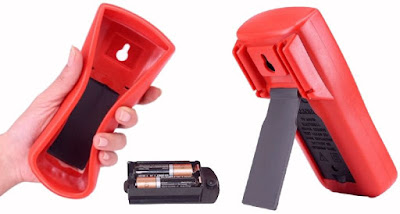 |
| The AN 870 in its flexible plastic sheath. (© 2021 Jos Verstraten) |
The display and the control buttons
The meter has a monochrome LCD display measuring 62 mm by 38 mm with 'old fashioned' seven-segment digits of 21 mm height. The display has no backlight, which is a big disadvantage when measuring in poorly lit rooms. By pressing the 'HOLD' button for more than two seconds, the display can be illuminated by a white LED located on the left-hand side of the display. However, the result of this action is minimal.
The rotary knob has a diameter of 44 mm and is easy to operate. However, the knob turns rather stiff, so you have to hold the meter in your left hand if you operate the knob with your right hand.
The AN870 has six push buttons with the following functions:
- SELECT
Selects between DC or AC; between mV, °C or °F; between resistance, capacitance or continuity and between AC voltage, frequency or duty cycle. - HOLD
Press shortly to freeze the display and long to turn the backlight on or off. - RANGE
Press shortly to enable the manual range selection. Each short press selects the next range. Press longer than two seconds to activate automatic range selection. - REL
Activates the relative mode. The current reading is stored in the meter memory as a relative zero. This value is automatically subtracted from all new readings. Ideal, for example, for compensating the resistance of the measuring leads when measuring low resistance values. - MAX/MIN
When this button is pressed for the first time, only the maximum value measured is displayed. The second press displays only the minimum value measured. Press for more than two seconds to exit the MAX/MIN mode. - Hz/%
When the rotary switch is in the 'V~' position, the switch is pressed to measure the frequency or duty cycle of the AC voltage at the input.
 |
| The control buttons of the AN870. (© AliExpress) |
The 'Auto Power Off' Mode
Turning the rotary switch on the AN870 from the 'OFF' position automatically puts the meter in the 'Auto Power Off' mode. The text 'APO' will appear on the top left of the display and the meter will turn itself off after fifteen minutes of inactivity. One minute before this action, the meter will beep five times. If you want your AN870 to be on continuously, press and hold the 'SELECT' button while turning the meter on.
The electronics in the AN870
The printed circuit board
After you have removed the meter from its jacket with some effort, you will see four small crosshead screws on the back. After removing these screws, you can open the housing of the meter. The single printed circuit board is precisely tailored and contains all parts.
What immediately catches the eye are the two large sand-filled glass fuses, size 6.3 mm x 32 mm, that are directly connected to the two current inputs '20A' and 'mA/μA' on the front panel. These fuses have a breakdown voltage of 250 Vac and ensure that, if they should accidentally burn out, no voltage flashover can take place in or across the fuse. One fuse has a value of 200 mA, the other one 20 A. Between both fuses there is room for the battery holder, you can see the contact strips in the middle of the PCB.
The shunt resistors for the current measurements have a value of 0.01 Ω for the 20 A range (R33) and of 1.0 Ω for the mA/μA range (R24). The 0.01 Ω resistor and the 20 A fuse are connected to the connectors on the front panel with wide PCB traces on both sides of the PCB. Moreover, these traces are covered with a layer of tin.

The 4 mm banana socket for the voltage measurements is connected to the electronics via two 5 MΩ resistors (R29 and R30) connected in series. The voltage input of the chip is protected against too high voltages by means of a PTC (PTC1) and two transistors (Q3 and Q4).
On the PCB you will see an EEPROM of type P24C02A (IC1). This memory is probably used to store the calibration data. After all, modern multimeters are no longer calibrated via adjustment potentiometers, but via digital values that the processor uses to correct the measured values.
Q5 is a voltage reference of 1.2 V of type ICL8069.
The two transistors Q1 and Q2 are probably responsible for controlling the buzzer and the lighting of the display.
The back of the PCB contains no parts, just some traces, the contact strips for the rotary switch and for the display.
 |
The printed circuit board of the AN870. (© 2021 Jos Verstraten) |
The input connectors
The four input connectors are constructed in the simplest way possible by bending a piece of metal cylindrically and hoping that the resilient properties of such a construction would guarantee good contact with the test leads in the long term. In our humble opinion, this could have been done a bit more professionally! Of course, these contacts still fall into plastic insulators when PCB and housing are screwed together, but the long-term stability is still a point of doubt.
 |
| The rather clumsy construction of the input connectors. (© lygte-info.dk edited by Jos Verstraten) |
The Aneng AN870 on the test bench
The DC millivolt ranges
The AN870 has two DC mV ranges: 19.999 mV and 199.99 mV. The specified accuracy is ±(0.05 % + 3). To generate such small voltages, we use a digitally adjustable power supply, terminated with a 1/100 resistive attenuator. As a reference meter we use our newest acquisition (thanks to our sponsors and donors), a Fluke 8842A multimeter. It is connected in parallel with the AN870. The power supply is adjusted until the voltages measured on the Fluke approach the desired test values of 10 mV, 20 mV, 50 mV and 100 mV. The results are summarized in the table below and speak for themselves. Excellent performance of the AN870!
 |
| The accuracy in measuring small DC voltages. (© 2021 Jos Verstraten) |
The DC volt ranges
The AN870 has four ranges: 1.9999 V, 19.999 V, 199.99 V and 1000.0 V. The specified accuracy for these measurements is also ±(0.05 % + 3). In the table below, the indication on the AN870 is compared to the one on the Fluke 8842A. So the results are a little worse than when measuring millivolt voltages, but with an average deviation of 0.068 % nobody can be dissatisfied. Of course, the slightly worse results can also be due to the fact that for most test voltages only four of the five digits were active.
 |
Accuracy when measuring larger DC voltages. (© 2021 Jos Verstraten) |
The DC current ranges up to 2 A
The AN870 has 3 x 2 current ranges: 199.99 μA, 1999.9 μA, 19.999 mA, 199.99 mA, 1.9999 A and 19.999 A. The accuracy is specified as ±(0.5 % + 3). The AN870 is connected in series with the 8842A to the power supply which is set as a constant current source. Since our power supply can only deliver two amps and the Fluke can only measure up to 1.99999 A, the measurements are limited to that value. The results are summarised in the table below. With an average error of 0.45 %, the tested sample is nicely within its specifications.
 |
| Accuracy in measuring DC currents. (© 2021 Jos Verstraten) |
Measuring large currents
The AN870 can, according to the manufacturer, measure currents up to 20 A. There is nothing in the manual or on the device that indicates a necessary limitation of the time of such measurements. In several reviews of the AN870 it is claimed that the circuit board traces and the 20 A shunt cannot withstand such large currents for long. We have a 12 Vdc power supply that can deliver 30 A, ideal to source such a high current to the AN870! The power supply is loaded with the series connection of the multimeter and two resistors of 1 Ω and 100 W connected in parallel. The meter is opened and at six points in the 20 A measuring circuit the temperature is measured with an exposed thermocouple and heat-conducting paste.
The initial current decreases fairly quickly to a value of 15 A. This is due to the positive temperature coefficient of the wire-wound resistors. The results of this test are summarised in the figure below. After ten minutes the temperatures have stabilised and the measurement is aborted. The measured values are not disturbing.
It is true that this measurement was performed with an opened AN870 and the generated heat can therefore be dissipated much more easily than in a closed meter. But this test still proves that you can measure currents of more than 10 A for a short while without any problems.
Interesting to note is that the meter starts to beep intermittently when you measure more than 10 A.
 |
| The heat development when measuring 15 Adc. (© 2021 Jos Verstraten) |
The AC millivolt ranges
Two ranges available, 19.999 mV and 199.99 mV, with specified accuracy of ±(0.3 % + 3). Because in practice such ranges are mainly used for measuring small signal voltages, we perform this test at a frequency of 1 kHz. The problem is that we do not have a good reference meter for such small signal voltages. Our digitally adjustable function generator UTG9005C-II from Uni-Trend has a setting accuracy of only ±3 %. So do not consider the results summarised in the table below as an absolute indication of the accuracy of the AN870, but rather as an indication that the meter does give reliable results in this field.
 |
| Measurement of small sine wave signals of 1 kHz. (© 2021 Jos Verstraten) |
The AC volt ranges
The AN870 has four ranges: 1.9999 V, 19.999 V, 199.99 V and 750.0 V with a specified accuracy of ±(0.3 % + 3). For testing these functions we use a variac and our VC650BT multimeter from Voltcraft. However, this has an accuracy comparable to that of the AN870 and can thus not be used as a reference. Therefore, in the table below we have only compared the measurements without calculating a percentage deviation.
 |
| Measurement of larger sine voltages of 50 Hz. (© 2021 Jos Verstraten) |
The sine wave bandwidth
The manual does not say a word about this rather important specification. We have measured the bandwidth with a sine wave signal of 1 Vrms. The results are shown in the table below. If we define the bandwidth as the frequency at which the reading is reduced by 3 dB or up to a factor of 0.707, then the AN870 appears to have a bandwidth of approximately 3 kHz.
 |
| Determination of the bandwidth at 1 Vrms sine wave. (© 2021 Jos Verstraten) |
The accuracy of the root mean square value
Like all modern meters, the AN870 measures the rms value of AC voltages. This is the value of the AC voltage that generates the same thermal power in a resistor as a DC voltage of the same value. The table below shows how the AN870 displays the rms value of three different signal shapes with a value of 1 Vrms.
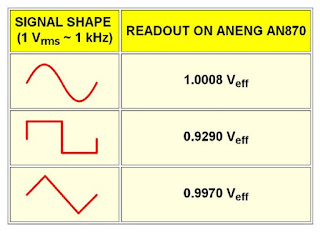 |
| The accuracy of rms measurements. (© 2021 Jos Verstraten) |
Measuring frequencies
The AN870 has six measurement ranges from 99.99 Hz to 9.999 MHz full scale with a specified accuracy of ±(0.1 % + 2). It is not easy to test the frequency measurement range of a multimeter. After all, this range depends on a number of factors, such as signal amplitude and signal shape. To give you an impression, we have measured with a sine wave signal with a value of 1 Vrms. The results are summarised in the table below.
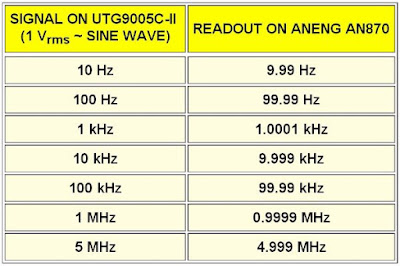 |
The accuracy of frequency measurements. |
Measuring the duty-cycle
The duty-cycle or on/off ratio of a square wave signal indicates how much of the period the signal is 'H'. A symmetrical square wave has a duty-cycle of 50 %. The AN870 measures this quantity in one range from 1 % to 99 % with an accuracy of ±(0.1 % + 2).
We test this at frequencies of 1 kHz and 1 MHz, see the table below. The signal has an amplitude of 1 V.
 |
| Measuring the duty cycle of square waves. (© 2021 Jos Verstraten) |
Measuring resistances
The AN870 has seven resistance ranges, from 199.99 Ω to 199.99 MΩ full scale. The specified accuracy depends on the range, from ±(0.2 % + 3) in the most common ranges to ±(5.0 % + 5) in the highest range. Since our Fluke 8842A also measures resistors very accurately, we considered its reading to be the 100 % reference. The results are summarised in the table below. We compensated the resistance of the test leads by measuring relatively with the AN870 and by using the four-wire method with the 8842A. With an average deviation of 0.12 %, the tested device more than meets expectations.
 |
| Accuracy in measuring resistors. (© 2021 Jos Verstraten) |
Measuring capacitors
The AN870 measures in seven ranges from 9.999 nF to 9.999 mF full scale. The accuracy is specified as ±(2.0 % + 5) in the most used ranges up to ±(5.0 % + 20) in the extreme ranges. In the absence of accurate measuring equipment, we have to use our set of capacitors with a guaranteed tolerance of ±1.0 %. The results are summarised in the table below. The deviations at the lower values are in any case not due to the parasitic capacities of connecting cables. In that case, the measured values should be higher than the capacitor values.
 |
| The accuracy of measuring ±1 % capacitors. (© 2021 Jos Verstraten) |
Measuring temperatures
There are some remarks on the supplied thermocouple probe, see the figure below. In the first place, we find the coiled cord very clumsy. Secondly, we are not very happy with the way the cable is attached to the two banana plugs. The very thin wires are screwed into the banana plugs without any kind of strain relief. That will not last long! Finally, the probe looks nice, but it is extremely unsuitable for monitoring the temperature of an electronic component. For this, give us a so-called 'exposed thermocouple' (see inset) that absorbs much less heat and measures the temperature of, for example, a transistor much more accurately and quickly.
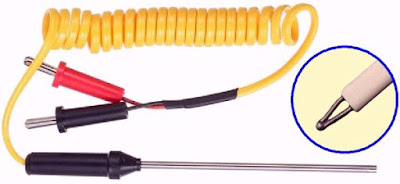 |
The supplied thermocouple probe. (© AliExpress) |
The AN870 has one temperature range of -20 °C to +1000 °C with a specified accuracy of ±(2.5 % + 5). We do not yet have an accurate temperature meter (with some extra donations we can do that in no time), so we compared the results of the AN870 with those of our TM-902C with identical accuracy. For this test, both thermocouples were rigidly attached to each other and immersed in slow heating water. The table below shows the results of both thermocouples compared.
 |
| The temperature measurements compared. (© 2021 Jos Verstraten) |
In the 'NCV' function of the rotary switch, you can measure the mains voltage without contact. The display shows 'EF' when the meter is not in use. If you hold the meter with the top against the wall, you can detect the position of a live wire in the wall. If the AN870 detects an electromagnetic field, the meter will beep and a number of dashes will appear on the display. As you get closer to the wire, more dashes will appear on the display and the meter will beep faster. However, the accuracy of this function is not very high.
This function can also be used, at least according to the manual, to detect the live and neutral wires in a wall socket. Connect the red connector 'V/Ω/Hz' with one test lead to the pins of a wall socket. If the lead is in the neutral terminal, the indication 'EF' remains on the display. If the lead is in the live terminal, four dashes will appear on the display and the AN870 will beep rapidly.
However, for these kind of measurements, we rather trust the old voltage detector with a neon bulb!
Our conclusion on the Aneng AN870
We can discover few properties of this meter where critical remarks are appropriate. The manufacturer could have made the four input connectors a little more professional and the back support a little more solid. The specifications measured by us almost all meet the values stated by the manufacturer. We think that the AN870 is a beautiful multimeter for every electronics hobbyist!

Aneng AN870 multimeter
